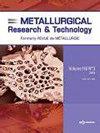Modeling of supersonic jet behavior in the vacuum refining process
IF 1.1
4区 材料科学
Q3 METALLURGY & METALLURGICAL ENGINEERING
引用次数: 1
Abstract
There are two problems to be solved in the numerical simulation of the top blown oxygen vacuum refining process. (1) The two-equation turbulence models underpredict the turbulence mixing shear process for high-temperature gradient jet flows. (2) The high compressibility of the jet in a low vacuum environment. In this study, the SST k-ω turbulence model is modified by the composite function of the compressibility factor and the total temperature gradient. Based on the experimental model of the Kotani vacuum jet, the modified turbulence model was used to simulate the supersonic jet behavior of oxygen lance at different ambient temperatures. The reliability of the model is verified by the semi-empirical formula of Ito and Muchi. The simulation results show that the entrainment rate is an important inducing factor. The potential core length and the supersonic core length at the temperature of 1800 K are 2.5 times and 2.0 times that at the temperature of 285 K, respectively. Besides, based on the ejection model established by Ricou and Spalding, the calculation formula of turbulence entrainment rate at different ambient temperatures is obtained. This research work will benefit greatly to the supersonic jet behavior in Vacuum Refining.真空精炼过程中超音速射流行为的建模
顶吹氧气真空精炼过程的数值模拟需要解决两个问题。(1)双方程湍流模型低估了高温梯度射流的湍流混合剪切过程。(2)射流在低真空环境下的高压缩性。本文采用压缩系数和总温度梯度的复合函数对海表温度k-ω湍流模型进行了修正。在小谷真空射流实验模型的基础上,采用改进的湍流模型模拟了不同环境温度下氧枪的超音速射流行为。用Ito和Muchi的半经验公式验证了模型的可靠性。仿真结果表明,夹带率是一个重要的诱导因素。在1800 K温度下,电势核长度和超音速核长度分别是285 K温度下的2.5倍和2.0倍。此外,基于Ricou和Spalding建立的弹射模型,得到了不同环境温度下湍流夹带率的计算公式。该研究对真空精炼过程中超音速射流的性能研究具有重要意义。
本文章由计算机程序翻译,如有差异,请以英文原文为准。
求助全文
约1分钟内获得全文
求助全文
来源期刊

Metallurgical Research & Technology
METALLURGY & METALLURGICAL ENGINEERING-
CiteScore
1.70
自引率
9.10%
发文量
65
审稿时长
4.4 months
期刊介绍:
Metallurgical Research and Technology (MRT) is a peer-reviewed bi-monthly journal publishing original high-quality research papers in areas ranging from process metallurgy to metal product properties and applications of ferrous and non-ferrous metals and alloys, including light-metals. It covers also the materials involved in the metal processing as ores, refractories and slags.
The journal is listed in the citation index Web of Science and has an Impact Factor.
It is highly concerned by the technological innovation as a support of the metallurgical industry at a time when it has to tackle severe challenges like energy, raw materials, sustainability, environment... Strengthening and enhancing the dialogue between science and industry is at the heart of the scope of MRT. This is why it welcomes manuscripts focusing on industrial practice, as well as basic metallurgical knowledge or review articles.
 求助内容:
求助内容: 应助结果提醒方式:
应助结果提醒方式:


